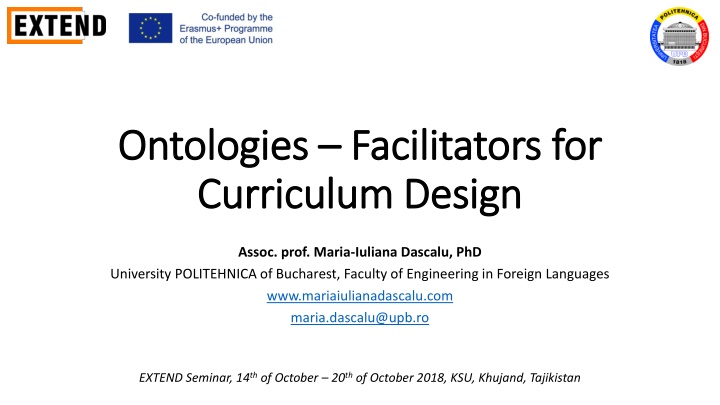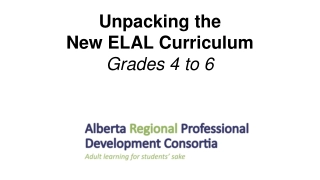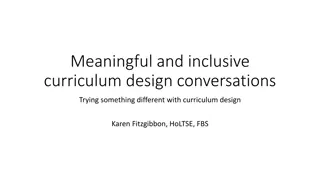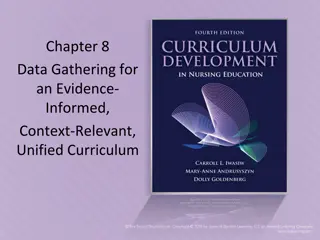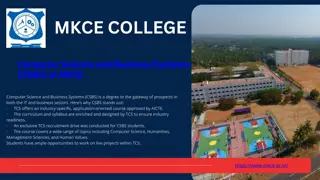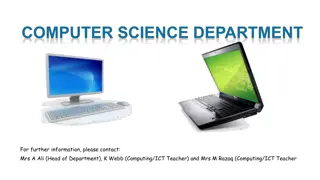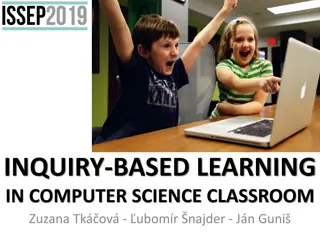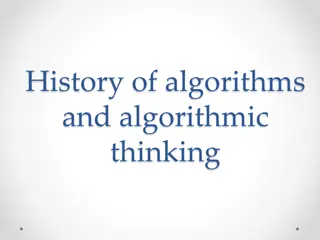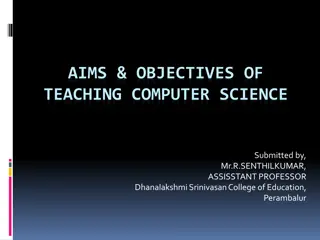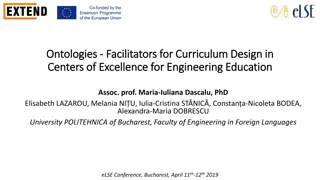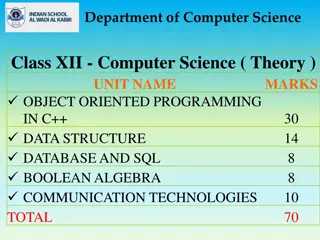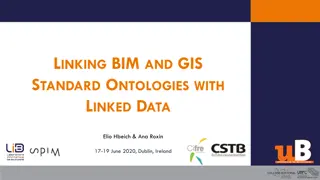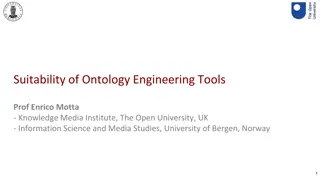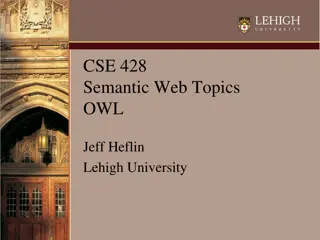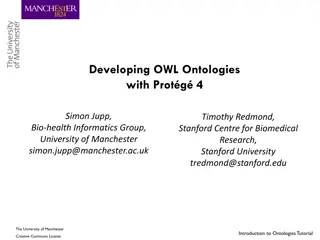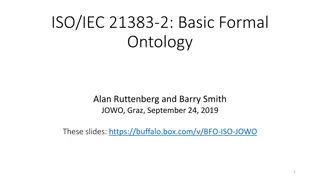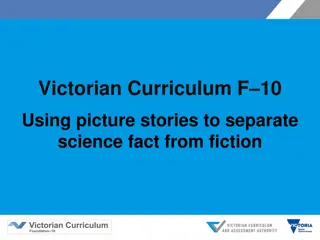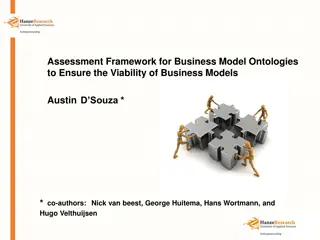Ontologies in Curriculum Design and Computer Science
Explore the role of ontologies in curriculum design and computer science, delving into their origins, components, and structures. Discover how ontologies facilitate shared conceptualizations and formal specifications in various domains.
Download Presentation

Please find below an Image/Link to download the presentation.
The content on the website is provided AS IS for your information and personal use only. It may not be sold, licensed, or shared on other websites without obtaining consent from the author.If you encounter any issues during the download, it is possible that the publisher has removed the file from their server.
You are allowed to download the files provided on this website for personal or commercial use, subject to the condition that they are used lawfully. All files are the property of their respective owners.
The content on the website is provided AS IS for your information and personal use only. It may not be sold, licensed, or shared on other websites without obtaining consent from the author.
E N D
Presentation Transcript
Ontologies Ontologies Facilitators for Facilitators for Curriculum Design Curriculum Design Assoc. prof. Maria-Iuliana Dascalu, PhD University POLITEHNICA of Bucharest, Faculty of Engineering in Foreign Languages www.mariaiulianadascalu.com maria.dascalu@upb.ro EXTEND Seminar, 14thof October 20thof October 2018, KSU, Khujand, Tajikistan
Ontology: Origins and History Ontology: Origins and History a philosophical discipline a branch of philosophy that deals with the nature and the organisation of reality science of being (Aristotle, Metaphysics, IV, 1)
Ontology in Computer Science Ontology in Computer Science an engineering artefact: specific vocabulary used to describe a certain reality a set of explicit assumptions regarding the intended meaning of the vocabulary describes a formal specification of a certain domain: shared understanding of a domain of interest formal and machine manageable model of a domain of interest an explicit specification of a conceptualization=> shared conceptualization of a domain of interest
Structure of an Ontology Structure of an Ontology Ontologies typically have two distinct components: Names for important concepts in the domain (common vocabulary) Background knowledge/constraints on the domain Example: Names for important concepts in the domain: Elephant is a concept whose members are a kind of animal Herbivore is a concept whose members are exactly those animals who eat only plants or parts of plants AdultElephant is a concept whose members are exactly those elephants whose age is greater than 20 years Background knowledge/constraints on the domain: AdultElephants weigh at least 2,000 kg All Elephants are either AfricanElephants or IndianElephants No individual can be both a Herbivore and a Carnivore
Whats inside an OWL ontology? What s inside an OWL ontology? Classes/concepts + class-hierarchy: subclasses of Animal Male, Female; Female and Male are disjoint classes. Individuals/objects/instances: Peter and Ian are objects in the class Man Relations between classes(inheritance, disjoint_with, equivalence ) Properties (slots) / values: Object properties, relations between instances of two classes: Maria isMarried Tom Datatype properties, relations between instances of classes and literals/datatypes: Maria hasAge 35 Characteristics of properties: symmetric - isMarried transitive- has Ancestor functional hasMother (Mary hasMother MrsRobinson, Mary hasMother Anne=>Mrs Robinson is Anne) inverse functional hasStudentNumber (Mary hasStudentNumber 87324, MsSmith hasStudentNumber 87324 => Mary is MsSmith) Restrictions on properties (type, cardinality): The parent of a Person is also a Person => type of parent is Person Any person must have exactly 1 father = > cardinality of hasFather property is 1. Annotations (comments ) Reasoning tasks: classification, consistency checking
Example: ontology of Example: ontology of an university an university http://www.cs.man.ac.uk/~rector/ Modules/CS646- 2004/Labs/Thursday/Simple_Unive rsity-01.owl
With Protg software: https://protege.stanford.edu/
With Protg software: https://protege.stanford.edu/
With Protg software: https://protege.stanford.edu/
Usage of ontologies Usage of ontologies Ontologies terminological confusion by providing a unified framework for describing the concepts of the world and their relations -> improve communication and cooperation between people and organizations reduce conceptual and Ontologies are cross-platforms, cross- applications interoperability -> improve M. Al-Yahya, R. George, and A. Alfaries, Ontologies in e-Learning: Review of the Literature, Int. J. Softw. Eng. Its Appl., vol. 9, no. 2, pp. 67 84, 2015. Provide specification reusability, reliability,
Usage of ontologies Usage of ontologies
Ontologies in curriculum development Ontologies in curriculum development Foster the transparency, collaboration, exchangeability and interoperability (M. C. Van der Wende, The Bologna Declaration: Enhancing the Transparency and Competitiveness of European Higher Education, J. Stud. Int. Educ., vol. 4, no. 2, pp. 3 10, 2000) Support the aligning, classification, comparing, and matching between universities, educational systems or relevant disciplines (H. Chung and J. Kim, An Ontological Approach for Semantic Modeling of Curriculum and Syllabus in Higher Education, Int. J. Inf. Educ. Technol., vol. 6, no. 5, pp. 365 369, 2016) Help in managing the educational offerings of an institution, revealing useful information like course overlapping, uncovered or less covered areas, possible synergies between courses (M. Ronchetti and J. Sant, Curriculum Management and Review: an ontology-based solution, Trento, Italy, 2007) Supports personalization, recommendation etc in e-learning (M.I. Dascalu & all, How social and semantic technologies can sustain employability through knowledge development and positive behavioral changes, Computers in Human Behavior, vol. 70, pp. 507-517, 2017)
Examples of ontologies in curriculum development Examples of ontologies in curriculum development The Bologna Ontology: http://diuf.unifr.ch/main/xi/bowlogna BBC Curricula Ontology: https://www.bbc.co.uk/ontologies/curriculum CCSO: http://xworks.gr/ontologies/ccso.owl (EVANGELOS KATIS, Semantic Modeling of Educational Curriculum & Syllabus, TECHNOLOGICAL EDUCATIONAL INSTITUTE OF CRETE,2018)
Interrogating the Interrogating the ontology with ontology with SPARQL SPARQL Which Courses cover a certain Knowledge Area?
Exercise Exercise Identify some use cases for creating the EXTEND ontology.
Starting points for EXTEND ontology Starting points for EXTEND ontology
Exercises Exercises create EXTEND ontology create EXTEND ontology Design your center curriculum using ontologies on paper (20 minutes): Define at least 5 classes/concepts 5 minutes Define the relations between those classes - object properties 5 minutes Define the characteristics of those properties (symmetric, transitive,functional, inverse functional) 5 minutes Define 3 instances/individuals for one of the classes of your ontology 5 minutes Put everything in Prot g (https://protege.stanford.edu/), save it and send it to maria.dascalu@upb.ro (20 minutes)
